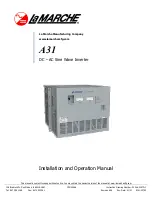
Connecting to 12-volt Battery or 12-volt DC Using Supplied Cables
The Power Inverter is equipped with two screw connectors to attach the cable leads to the Inverter.
The red is positive (+) and the black is negative (-).
1.
Select the OFF position on both the Inverter and the remote outlet.
2.
Remove the red positive (+) screw connector cap.
3.
Slide the red positive (+) cable lead onto the red positive (+) screw connector stud. Tighten the
screw connector cap securely.
4.
Remove the black negative (-) screw connector cap.
5.
Slide the black negative (-) cable lead onto the black negative (-) screw connector stud. Tighten
the screw connector cap securely.
6.
Securely connect the red positive (+) cable lead to the positive (+) terminal of the battery or
power source.
7.
Securely connect the black negative (-) cable lead to the negative (-) terminal of the battery or
power source.
8.
Connect a #12 AWG or larger insulated wire between the chassis ground connector on the
Inverter and a clean electrical grounding point on the vehicle. This will minimize possible electrical
noise interference when using TVs or radios.
Do not connect the grounding wire to the negative (-) terminal of the power source.
Only connect this wire to a clean grounding point on the vehicle.
Hard-Wire to Power Source
The Power Inverter can be hard-wired to the DC power source. A 200-amp ANL fuse or DC circuit
breaker should be installed to protect the circuit.
Determining Proper Cable Length and Gauge
Measure the distance between the Power Inverter and the power source. See SPECIFICATIONS
for the proper cable gauge to use. Using excessively long or insufficient gauge cables will cause low
battery power. Also, using improper cables will reduce battery operation time.
Only use copper cables to connect the Power Inverter to the power source. Do not
use aluminum cables. Aluminum cables have approximately 1/3 more resistance than copper
cables of the same size.
Only use proper size cable connectors to connect the cables to the Inverter and
power source. Be sure the cable connectors are properly installed onto the ends of the cables.
Installing Cables
1.
Select the OFF position on both the Inverter and the remote outlet.
2.
Install the 200-amp ANL fuse or DC circuit breaker onto the positive (+) terminal of the power
source. Remove the fuse from the fuse holder before installing the fuse holder or turn off the
circuit breaker. If the fuse holder or circuit breaker cannot be installed onto the terminal, use a
short length of the recommended cable gauge to connect the fuse holder or circuit breaker to the
terminal. Identify this cable as positive (+).
3.
Secure the remaining end of the fuse holder or circuit breaker to the positive (+) cable. Connect
the positive (+) cable to the red positive screw connector on the Inverter. Tighten the screw
connector securely.
4.
Connect the negative cable between the negative (-) terminal of the power source and the black
negative (-) screw connector on the Inverter. Tighten the screw connector securely.
5.
Connect a #12 AWG or larger insulated wire between the chassis ground connector on the
Inverter and a clean electrical grounding point on the vehicle. This will minimize possible electrical
noise interference when using TVs or radios.
Do not connect the grounding wire to the negative (-) terminal of the power source.
Only connect this wire to a clean grounding point on the vehicle.
FIRE HAZARD
Verify that all connections are secured. A loose connection may cause damage to the Inverter
and/or create a spark.
6.
Verify that the positive (+) cable is connected between the positive (+) terminal of the power
source and the red positive (+) screw connector on the Inverter. Also, verify that the negative (-)
cable is connected between the negative (-) terminal of the power source and the black
negative (-) screw connector on the Inverter.
If the cables are not connected correctly, the Power Inverter will be damaged.
7.
Install the fuse in the fuse holder or turn on the circuit breaker.































